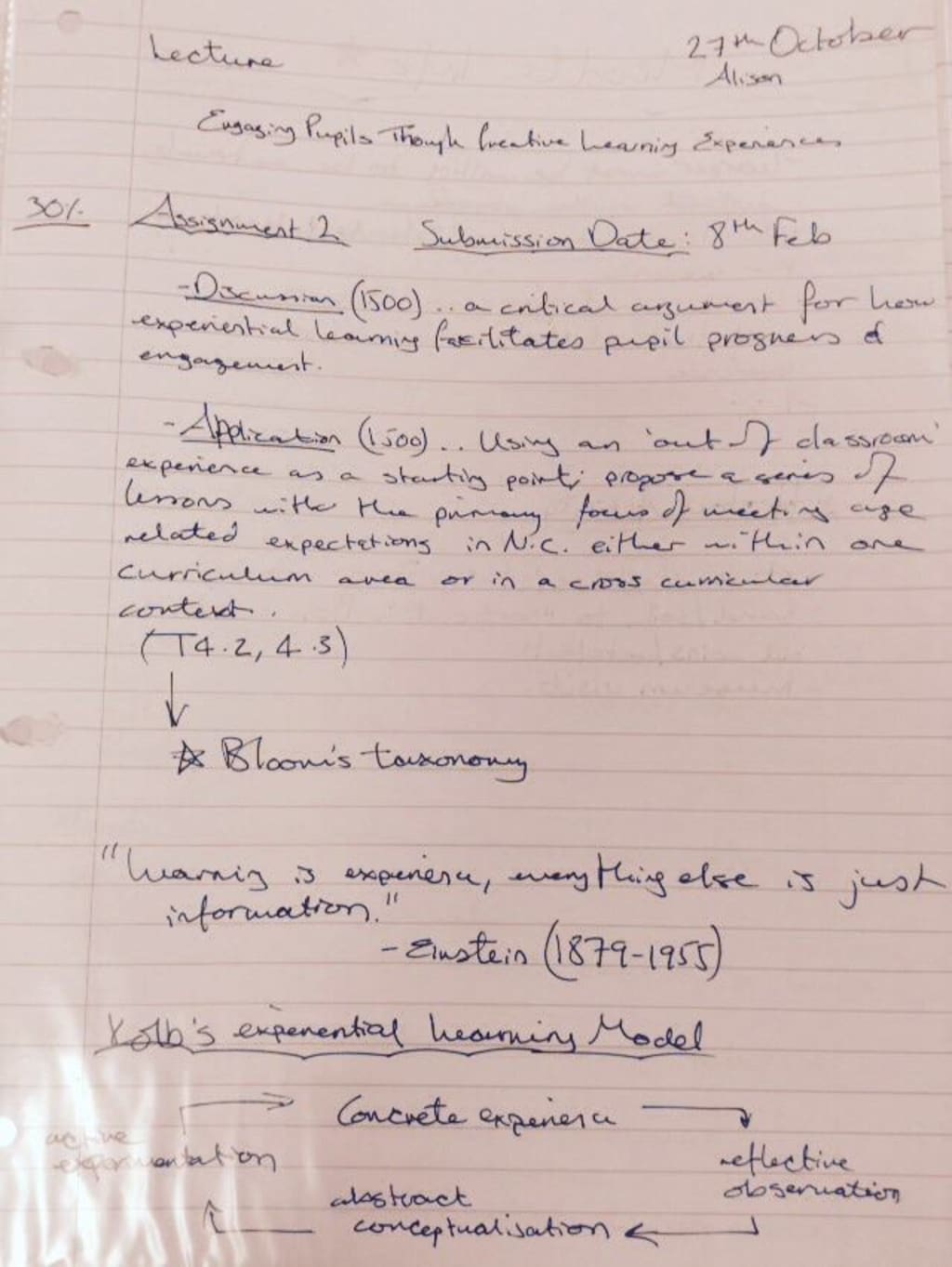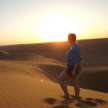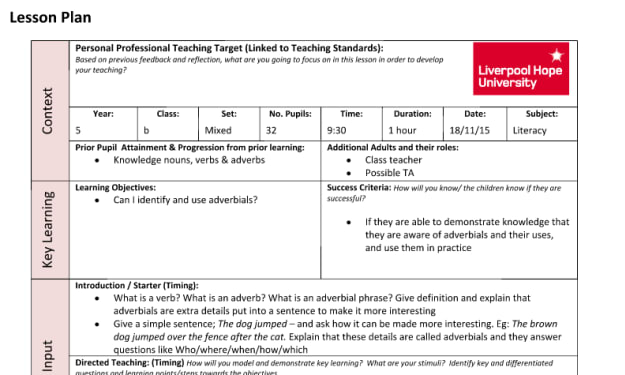Creative Approaches to the Curriculum
An essay of mine from my teacher training days.

There are many methods within schools today that work to further facilitate pupil progress and maintain engagement and the motivation to learn. Though it has come far from the traditional schoolrooms of desks and chalkboards, the execution of education is an ever changing concept, with new ideas constantly being put forward and tested in attempt to improve its functionality and success. One of these being the process of experiential learning; the concept of learning through experience. However the debate of how education should be run is often in conflict as traditional ways clash with modern ideas and poses the question; "Does creativity flourish better in an informal classroom where children are responsible for much of their own work and for initiating a great deal of what goes on, or is it at its best in a more formal, structured context?" (Fontana, 1991)
The idea of promoting creativity in the classroom and the curriculum has long been a recognised goal. 20th-century artist Picasso famously said that "All children are born artists, the problem to remain one as we grow up"(n.d.). However historically, the curriculum was always built upon the subjects that, certainly in times of the industrial revolution, would ensure jobs to individuals, promoting a strict hierarchy starting with maths, reading, writing and languages, and ignoring the arts. Though it has been proved since that careers can materialise from all subjects and talents, as time has moved forward, fundamentally this way of education has not changed and the emphasis on academia remains the same. "We start to educate [children] progressively from the waist up, and then we focus on their heads" (Robinson, 2006). Sir Ken Robinson emphasises how children, and reflecting adults, may feel they were encouraged away from more creative subjects and opportunities to express oneself. Such a thing appears ever more likely to be true upon the realisation that we run "an education system where a mistake is the worst thing you can make" (Robinson, 2006), and often perceive creativity as a child "playing up" (Fontana, 1991).
"Creativity is an unpredictable thing" (Fontana, 1991) and can take many different forms as it differs from each person's perspective, making it an incredibly dynamic entity. David Fontana claims creativity to be "a special kind of thinking" and "the ability to generate fluent and novel ways of tackling problems" (1991). He builds his theories from Guilford's model of the structure of intellect that refers to thinking that individuals are either convergent or divergent thinkers, more specifically; where they are "said to converge upon the single acceptable answer to a problem rather than to diverge and throw up as may solutions as they can" (Fontana, 1991). Fontana emphasises that a teacher must give "opportunities for the encouragement of divergent thinking in students" and "should be prepared to operate in an atmosphere where [creativity] is [...] rewarded."
As well as encouraging the students to be creative, it is essential that the teachers themselves are creative in both their lessons and how they run the classroom, and mustn't be afraid to share their passions with the children. Many will be able to relate to experiences in their education where they felt a disconnection to a teacher because of their attitudes and thus resulted in their own lack of learning. Teachers "who enjoy sharing [their interests] with children" can incorporate these into planning and create vibrant lessons that feed off the teacher's excitement (Fontana, 1991, pp.120). Children can easily detect this enthusiasm in the teacher's input and it can result in placing them in an appropriate mindset to share the eagerness to learn, proving creative teachers to be "much more likely to prompt creature development in [...] children than teachers who are stereotyped and rigid" (Fontana, 1991). This creativity can materialise in infinite ways but through the process of experiential learning it proves to be specifically successful in promoting children's learning. Kolb claims that the concept can be linked "clearly to its intellectual origins in the work of Dewey, Lewin and Piaget" (Kolb, 1984). He underlines how Dewey's model of experiential learning (as seen below) is based on a pattern of continual learning and refreshing of knowledge that it initiated by a first impulse, or experience. Dewey stated that “We do not learn from experience, we learn from reflecting on experience” (Miller & Saxton, n.d.), emphasising that the initial experience provides the grounds for learning. Kolb also refers to Piaget's four stages of cognitive development. The first that Piaget identified as being was the sensorimotor stage; where learning takes places "through feeling, touching and handling" (Kolb, 1984). As the first stage, it provides the foundations for a child's cognitive development and curiosity and is built on from experiences throughout their infancy and adolescence. Although as the stages progress and the child becomes more able to learn in the more convenient ways of speaking and listening, the opportunity for physical learning within schools begins to decrease. Both Piaget and Dewey give a clear insight into the science behind experiential learning and how the ability to reflect on experiences can often be the more beneficial acquired knowledge. Within the classroom there is often not enough opportunity for this to take place efficiently, or is not to a sufficient standard that the children can benefit on a long-term scale. Kolb stated;
"The casual observer of the traditional educational process would undoubtedly conclude that learning was primarily a personal, internal process requiring only the limited environment of books, teachers, and classroom. Indeed, the wider 'real-world' environment at times seems to be actively rejected by the outside world." (1984)
Often we find children that are perfectly capable to use and apply their knowledge but struggle to relate it to an everyday situation, perceiving the outside world and their classroom to be two extremes which do not overlap. By "taking knowledge out of a vacuum," teachers are creating "an authentic experience ensures that creativity is grounded in relevant learning" (Henriksen & Mishra, 2013) which hopefully enables children to be able to reflect and draw a more meaningful message. This leaves margin for teacher and children to work together to control the content of the lessons adhering to the children's interests, the teacher can scaffold the outlines of the learning objectives and then further apply it to the worlds of the children both in and outside of school.
By providing children with interesting and creative lessons, we are making children more receptive to learning and generating the motivation to want to learn. As we uncover more about how we as humans learn, it has been long established that maintaining a constant engagement is key to consistent pupil progress. However it can prove difficult to ensure the constant engagement of each child, especially with lively children whom perhaps struggle with keeping still or quiet, and whom can distract other children. Temple Grandin identified there being three kinds of thinking; "Photo realistic visual thinking," "Pattern thinking," and "Verbal thinking," and while some children can easily learn from simply listening and absorbing facts and figures, others struggle and need a creative incentive in order to learn. Creative and energetic approaches to lessons can help the children who "need to move to think" (Robinson, 2006) by ensuring that they are always actively engaged and interested. Furthermore, regardless of their ways of thinking and learning, by giving a lesson an interesting twist or an element of fun, the children perceive it less as work and become more receptive to the learning involved. Often it is trying to generate enthusiasm for a subject that can hinder pupils in their progress, but the use of creativity and active learning in lessons can deter from that and lead to successes in both the children's work and understanding.
About the Creator
Louisa Jane
British.
Paediatric speech and language therpaist.
Art enthusiast.
Amateur-dramatics amateur.
Francophile.
Traveller.
People person.
Of the general happy-go-lucky sort :)






Comments
There are no comments for this story
Be the first to respond and start the conversation.